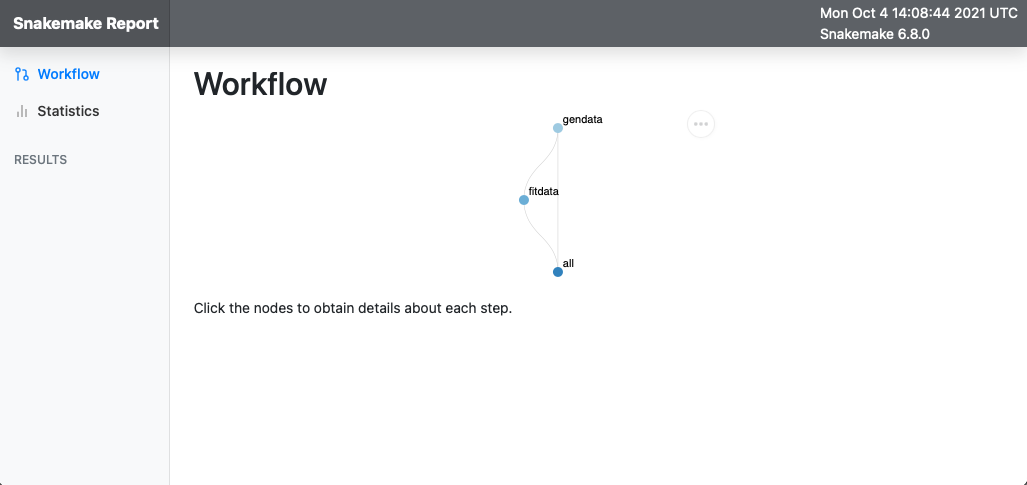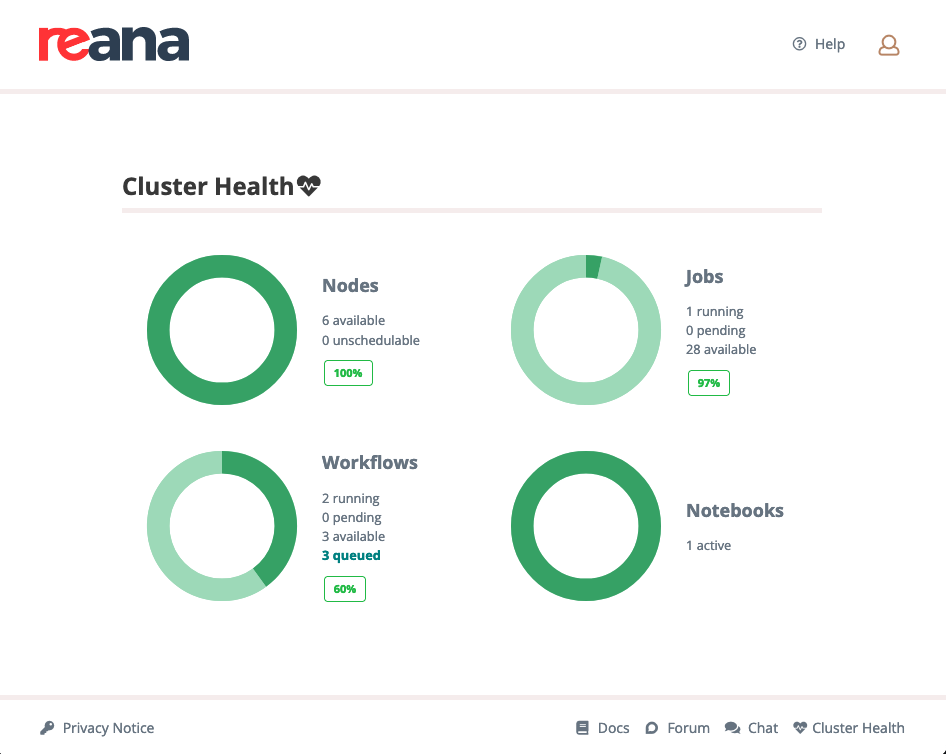We are glad to announce the release of REANA 0.8.1, a minor update that allows users to set job timeout limits, improves workspace web page file name filtering, allows displaying workspace HTML reports directly, and more!
What’s new for the users?
Configurable job timeout limits
If your workflow launches many hundreds of jobs and some of these may be
“running away” — for example when a job enters a state of infinite loop
waiting for external resources — it may be useful to set a hard limit on the
run time of potentially fragile jobs. This is now possible thanks to the new
kubernetes_job_timeout clause in the workflow specification:
steps:
- name: mystep
environment: 'docker.io/mydockerimage:1.0.0'
compute_backend: kubernetes
kubernetes_job_timeout: 3600
commands:
- ./mycommand mydata.root
You can set your preferred job timeout values (in seconds) differently in each workflow step. If a job exceeds the timeout, it will be forced to terminate. In this way your workflows will not get “stuck” and you will be able to inspect workflow logs for possible root cause causing the jobs to exceed the time limits.
If you don’t specify any time limit, note that the default time limit for any job will be 7 days.
Please see the custom job timeouts documentation page to know more about how to set the job timeout values in your CWL, Serial, Snakemake, or Yadage workflows.
Searching workspace files by name
If your workflow generates hundreds of files in the workspace, it is not easy to locate some particular file on the workspace tab of the workflow web page.
REANA 0.8.1 now allows searching your workspaces for desired file names. Inside the workspace tab of the workflow details page, there is a new search bar where you can type a part of the file name and the web interface will show only the files corresponding to your query:

Previewing HTML workspace files directly
In REANA 0.8.0, it was possible to preview plain text files and graphical images directly on the web interface. As of REANA 0.8.1, you can now also preview HTML files in your workspace without having to download them locally. This feature is particularly useful to visualise Snakemake execution reports that are automatically generated once the workflow finishes successfully:

Improved Cluster Health status web page
In REANA 0.8.0, a new “Cluster health” web page with the summary of the cluster status was introduced. Its purpose was to show the readiness of the cluster to run user workflows. The displayed charts were showing values based on the usage of existing cluster resources, showing information about cluster nodes, workflows, jobs, and notebooks.
As of REANA 0.8.1, the “Cluster health” web page was revamped to show values based on the availability of cluster resources instead. This makes the charts easier to read and easier to understand how many available resources the cluster has for running user workflows at any given moment.
Here is one illustrative picture of the new cluster health charts:

What’s new for the administrators?
Configure maximum job timeout limits
The newly introduced user-configurable job timeout limit feature forces
workflows to terminate when a certain amount of time is exceeded. In addition,
the cluster administrators can configure the maximum timeout limit for all user
jobs globally. This feature is always enabled and, by default, it has a value
of 7 days (604800 seconds). This means that, if a workflow job keeps running
for more than 7 days, it will be automatically terminated. This global
catch-all value can be configured by cluster administrators by setting the
kubernetes_jobs_timeout_limit Helm
value.
As an administrator, you can also set the maximum custom job timeout limit that
the users will be allowed to set in their workflow jobs. By default this value
is 14 days (1209600 seconds) and it can be customised at the deployment time
via the kubernetes_jobs_max_user_timeout_limit Helm
value.
Declare supported compute backends
As of REANA 0.8.1, you can declare which of the compute backends (HTCondor,
Kubernetes, Slurm) are supported in your REANA deployment. The users will be
able to see this information using the info command:
$ reana-client info
List of supported compute backends: kubernetes
This is useful to know which kind of workflows a user can launch on the given
REANA cluster instance the user is connected to. The information is also used
by reana-client validate to detect incompatibilities before the workflow
submission.
You can configure which compute backends are supported in your REANA deployment
by setting the compute_backends Helm
value.
Configure fine-grained server logging
The uWSGI configuration of the REANA-Server component has been changed to log all HTTP requests by default. In addition, you can also configure the following Helm values:
reana_server.uwsgi.log_all: Enables all the logging. It corresponds to the opposite of uWSGI optiondisable-logging.reana_server.uwsgi.log_4xx: It corresponds to the uWSGI optionlog-4xx.reana_server.uwsgi.log_5xx: It corresponds to the uWSGI optionlog-5xx.
Configure node labels for Database and Message Broker pods
There are new Helm configuration
options
node_label_infrastructuredb and node_label_infrastructuremq enabling a
possibility to run the Database and the Message Broker pods in specifically
dedicated cluster nodes. This can be useful for big clusters running thousands
of concurrent workflows where you want to isolate the DB and MQ services to
different nodes in order to improve the overall cluster performance for heavy
user load situations.
Configure periodic CPU quota usage updates
In REANA 0.8.0, an optional user quota usage accounting feature was introduced, permitting to keep track of the amount of CPU and Disk usage of users.
It was possible to update CPU and Disk quota usage upon workflow termination.
If the quota.termination_update_policy Helm value was set, then immediately
after workflow finished, both the CPU and the Disk quotas were calculated.
However, this could slow down the workflow termination procedures, which may
affect cluster performance in case of running thousands of concurrent user
workflows. This was especially true of the Disk quota updates, which REANA
0.8.0 allowed to configure to be updated periodically via a cron job, for
example every night, as governed by the quota.disk_update Helm value.
As of REANA 0.8.1, it is now possible to update both CPU and Disk quota
consistently, either during workflow termination or periodically. To reflect
this change, the Helm
values
quota.disk_update was renamed to quota.periodic_update_policy and the value
quota.termination_update_policy was renamed to
quota.workflow_termination_update_policy.
The old Helm value names are still recognised to guarantee backward compatibility.
How to upgrade existing REANA 0.8 clusters
If you are a REANA cluster administrator and you would like to upgrade from REANA 0.8.0 to REANA 0.8.1, you can optionally define the new Helm values listed above in your Helm values file:
$ vim myvalues.yaml
You can then use the Helm diff plugin to inspect the forthcoming change and then perform the upgrade using the standard Helm commands:
$ helm repo update
$ helm diff upgrade reana reanahub/reana --version 0.8.1 --values myvalues.yaml
$ helm upgrade reana reanahub/reana --version 0.8.1 --values myvalues.yaml
Further improvements and bug fixes
REANA 0.8.1 release comes with other minor improvements and bug fixes. Please see the detailed REANA 0.8.1 release notes for the complete list.
Enjoy!